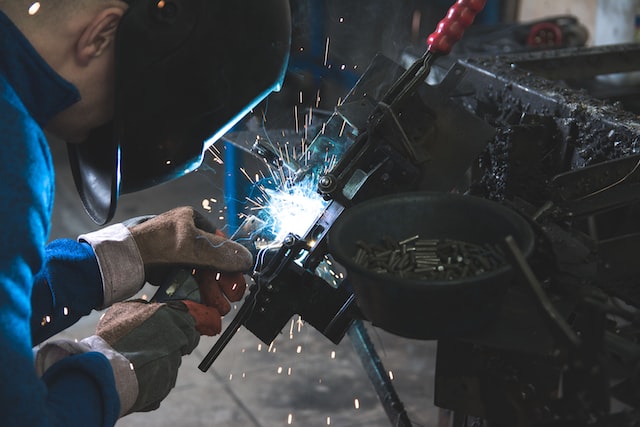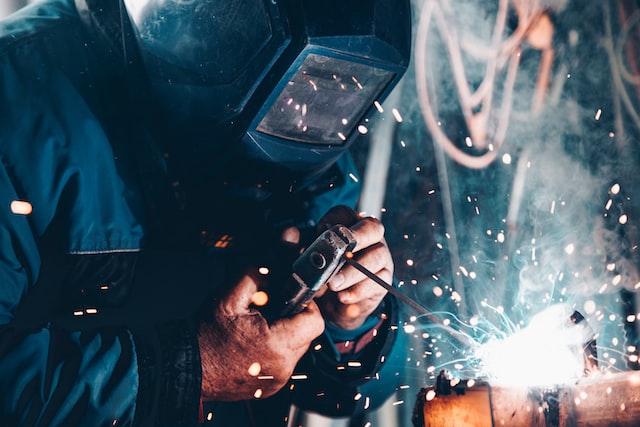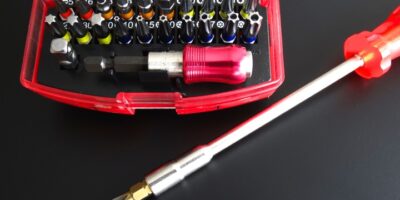While fusion welding is the most common and widely used procedure in the metal fabrication industry. There are occasions when you may not be able to use it and instead seek non-welding alternatives. As we along here, you will find information on combining metals without the use of welding. So, if you are looking for ways on joining metal without welding, this one is for you!
What Is Welding?

Even though it’s probably obvious to you what welding is, I’ll explain it briefly nevertheless. Welding is an industrial procedure used to securely combine metals and thermoplastics using heat and melting. The metal must cool down after joining to produce a strong bond. This type of welding can only be done by a machine or a trained welder.
Joining metal without welding is possible, however, the process can be done by hand. It depends on whether you have access to different resources, have had different experiences, or have different suggestions for doing the task.
Why Not Welding?
There are a number of valid arguments against welding metals, despite common belief to the contrary. Welding is a process that might be challenging in its entirety. For people without access to a welding machine or previous experience with welding, this is essential reading.
Welding is a potentially hazardous process, and it is likely that many individuals will find it unacceptable. More so, welding is a dangerous profession for someone without experience. For some consumers, the hefty up-front cost of a welding machine could be prohibitive.
You may be wondering if it isn’t better to hire a professional welder than to risk your own health and safety by purchasing your own welding equipment and doing the welding yourself. You see, employing a welder is also incredibly expensive. However, many individuals like solo factory work at home.
Joining Metal Without Welding: The Alternatives
In metalworking, it’s not uncommon to need to link together disparate components. Welding is how most people would naturally think to fix this. But that doesn’t make it the best or only choice. The post below will go through some alternate methods on joining metal without welding.
There are perhaps more methods than you realize that can serve as a substitute for welding. Adhesives and other procedures that call for training and special tools are present. Unlike welding, most of these alternatives provide less danger to the user. For this reason, they could be the best option for a newcomer.
Why Do We Need Non-Welded Metal Joints?
There may be times when we have to use a technique besides fusion welding to bring metals together. One or more of the following are only a few of the many possible explanations:
- There is a metallurgical incompatibility between some metals, making fusion welding impractical or unable to generate a strong junction.
- Some metals aren’t easily welded due to factors like their poor weldability or the fact that they react badly in the air.
- Welding is not required on all weldable joints in metalwork. A tack welded joint may be suitable for many joints since it can withstand the loads and temperatures encountered in normal operation.
- Joints that can be taken apart and put back together when necessary are useful in some situations. Mechanized fasteners make it possible to create such connections.
- Joining by riveting is often preferable to welding when aesthetics are of utmost importance, such as when constructing the body of an automobile or bus.
| PROS | CONS |
|---|---|
| Simple to get to. It’s available at any supermarket, pharmacy, or hardware store in your area. | The relationship can gradually weaken with time because it isn’t as strong and enduring as other systems. |
| No threat of hurting oneself or others | |
| Easily portable | |
| A low-cost approach |
Joining Metal Without Welding: The Different Ways
Several alternatives to welding are available for connecting metals together.
- Secure the metal pieces using adhesive.
- Brazing
- Soldering
- Riveting
- Attaching something mechanically
1-Bonding the Metals with Glue

This technique is suitable for attaching thin metal sheets in situations where neither force nor heat will be applied to the assembly. Epoxy, polyurethane, and silicon-based glues are examples of adhesives that work well for connecting aluminum and other light metals. The procedure is as follows:
Step 1 – is to ensure a flawless fit between the parts being linked.
Step 2 – is to thoroughly clean the components to ensure that they are free of any contaminants. Roughen up the bonding region with sandpaper. It’s important to keep the bonding area tidy.
Step 3 – use a brush or a spatula to spread the suggested glue over the bonding region.
✤ Techniques for Using Glue to Join Metal Parts
Once you have the correct type of metal glue as well some time, gluing two pieces of steel together is a breeze. Instructions with detailed illustrations are provided below:
- Work in a garage or other well-ventilated space. There should be room to store and access all of your equipment. To protect the floor and any closed furniture, spread out newspapers or drop cloths.
- Now, focus on the pieces that need to be affixed with adhesive. Examine the fit to make sure it will work. Remove any debris, dust, or leftover adhesive from the areas you’ll be gluing.
- Nitrile or latex gloves are recommended for added safety. Since you’re working with metal adhesive, you can forget about using PVC, cotton, or nylon.
🗹 Applying the Glue
Remove the lid and spread the glue evenly on both surfaces with a brush or spatula. Superglue may only need one drop per square inch, but epoxy metal glue may require extensive mixing.
🗹 Joining the Metal Pieces
Set the parts where they belong and squeeze them together. Fill in any spaces that could exist. Apply pressure for the specified amount of time, and then set them aside to cool.
🗹 Clamping and Curing
Remember that clamping time for metal epoxies is typically around an hour. When compared to superglues and polyurethanes, their cure times are significantly longer. Even yet, if you want a secure hold on the latter, clamping is still your best bet. If you want the glue to be fully set, you need to let the pieces sit undisturbed for at least a full night.
2-Brazing
Brazing involves bringing the metals to a high enough temperature so that they melt and unite. Therefore, there are many parallels to welding. It now acts more like a binder due to the filler metal.
The filler component used in brazing can be manufactured from a wide range of metals. Materials such as aluminum-silicon, copper-phosphorus, silver, nickel, cobalt, magnesium, etc. Because their melting points are so high, the brazing process may operate at greater temperatures.
✤ Ways of Joining Metal without Welding – Through Brazing
- Be sure the different base metals join well; capillary action relies on a clean interface.
- Having clean metal surfaces is critical for successful brazing. The rust, if any, should be removed once the grease and oil have been cleaned up.
- For joints to be brazed without the formation of oxides, the chemical substance known as flux must be applied to the surfaces of the joints beforehand.
- Use gravity if the pieces’ forms allow them to keep them in the correct brazing position when assembling.
- To braze an assembly, first, get it up to brazing temperature, and then fill the junction with filler metal.
- In order to get rid of the flux residue and the oxide scale that builds up after brazing, it’s important to give the assembly a thorough cleaning.
🗹 Tips for Brazing
Take a look at some videos or tutorials to get an idea of how to “wet” the joining surfaces and clean the material appropriately. Check that the torch and braze you plan to use are suitable for the metal you intend to work with.
| PROS | CONS |
|---|---|
| It’s an excellent method for joining pipes; it’s sturdy, doesn’t take much practice to master, and produces strong joints. Copper pipe joints made with them last for years even when subjected to extreme pressure. | Of course, experience is necessary, and there must be some overlap in the information for it to be useful. It’s not ideal for joining two pieces of metal together end-to-end (like two tubes that don’t nest within one another). |
| Nonferrous metals, such as copper, can benefit greatly from this technique. | It isn’t ideal for all metals and you’ll need a more robust torch (and more cash) for others. An oxyacetylene flame, which is typically used for brazing steel and iron, can cost several hundred dollars for a starter kit. |
3-Soldering

Soldering, like welding and brazing, requires the metal to be heated. In the same way that brazing does, this process calls for a filler metal. However, it’s not hot enough for brazing and is only around 800 degrees Fahrenheit at the moment.
Rather than using a mechanical connection, an electrical one is formed using this technique. Electronics and printed circuit boards are where you’ll find the greatest utility for this approach. Since this method is intended for electrical connections rather than mechanical ones, the resulting bond structure is predictably weaker.
✤ Soldering Technique Instructions for Joining Metal Parts without Welding
The first thing to do on joining metal without welding (through the method of soldering) is to gather all the required materials. Check the ones that you need before proceeding to the soldering process.
🗹 Collect the Material
- A tool for soldering
- Wet spongy
- Flux
- Brush
- Sandpaper
- Solder
- Wet rag
- Eye protection
- Gloves are designed for safety.
- Rolls of painter’s tape
🗹 The Soldering Process
- Allow the iron to heat up after plugging it in. While it’s healing, smooth out the weld seams by sanding the metal. This emphasizes the significance of a perfectly smooth surface.
- Remove any debris and cover anything you don’t want soldering with painter’s tape. Flux the areas that will get solder.
- Prepare your workspace so that you are not too close to the soldier at any point.
- Protect your eyes and hands by donning safety glasses and gloves.
- Prepare to begin soldering.
- After the procedure, the metal needs to cool.
- When everything has cooled, discard the surplus solder.
| PROS | CONS |
|---|---|
| The procedure temperature is significantly lower than that of welding or brazing | When compared to methods like brazing and welding, the bond created by soldering is significantly weaker. |
| Even soldering equipment can go wherever you go. | However, it has limited utility and cannot be employed in all situations. |
| Soldering is a very helpful technique when working with circuit-based gadgets. | Mechanically sound connections cannot be made using this technology; only electrical connections can be made. |
| Much less dangerous than welding. |
4-Riveting

Riveting is quite similar to the previously stated approach, and it is also an overlapping joint process. A riveting machine is used to secure two metal pieces together. In cases where an overlapping join with hardware is called for, you can accomplish the job with your hands.
Another method of attaching sheets of metal, this one creates a weld that is far more secure than the first. The method involves the use of fasteners to secure the surfaces together. All things considered, the fasteners are just like screws or bolts.
When compared to hinges, fasteners are employed as a constraint to hold items together or attach them to other hardware. You’ll want to set it up next to a hole you’ve already drilled and hammer the nail’s tail into position.
You can get a flat, enlarged result by pounding it until it widens at the shaft. Plates should have holes drilled and punched into them. The method chosen will depend on the thickness of the materials.
✤ How to Bond Metal to Metal for Riveting
- The plates will need to have holes drilled and punched into them, and this will depend on the depth of the sheets getting utilized.
- When you drill something, you should always be left with a burr.
- The metal parts must be securely fastened.
- One by one, rivets are inserted into the holes.
- After the rivet has been inserted, it should be struck hard to straighten out its head.
- When the parts have cooled, the rivets will draw them together.
🗹 Tips for Riveting and Bolting
As far as ease of use goes, pop rivets are in a league all their own. The equipment is inexpensive, and the process is simple and fast. This is the configuration I suggest using. It’s easy to bolt things together.
You can get everything you need at a hardware store. Just clarify your intended use, as there are many different varieties of fasteners available. In order to have the finest of both worlds, you should consider using a riveting screw inserter.
With the same idea as a popping riveting machine (squeeze the handles, and the nut swells until it’s firmly set in the metal), it creates a threaded hole in metal that may be fastened with a machine screw. It’s widely used for car customization and maintenance because it’s durable and sturdy.
| PROS | CONS |
|---|---|
| That’s the kind of thing that can be fixed for good with this. | There are times when it simply isn’t possible. Joining tubes with pop rivets, for instance, requires no effort. It’s possible that even if you succeed, the outcome will be less than ideal. Sheet metal is pretty much the only thing you can rivet. |
| The benefit of bolting is that it may be removed easily if necessary. As soon as you’re done, you can disassemble it. | While bolting may allow for greater adaptability, it also necessitates the addition of a nut or threads to one of the metal pieces. The end result is simply additional effort. |
| Pop riveting, in actuality, is easy to perform and calls for cheap, readily available equipment. | In either case, holes will need to be drilled and components aligned. |
Frequently Asked Questions
Q: Which three procedures join metal?
Fusion welding, pressure welding, and brazing/soldering are various types of joining used in the metalworking industry.
Q: Can metal be welded as effectively with glue?
Using the correct design, structural adhesives are as robust or tougher than welding. In order to enhance production processes, they can reduce the time and effort required for metal preparation and finishing. However, that’s just the start of it.
Q: Which adhesive bonds metal best?
Epoxy bonds metals the best. They’re made of glue and hardener.
Final Thoughts
It’s possible that welding is a strong and reliable method of joining metals. However, we may be hesitant to make such a decision due to the fact that it isn’t always essential and a number of other factors. The preceding explanation should have provided a wealth of options besides welding for joining metals together.
Even if some of the approaches we discussed are still complicated, they are typically simpler than welding. Moreover, most of them don’t require any particular background or education. They are also considerably less expensive. Now is the time to decide the method that will work best for your future metalworking venture.


